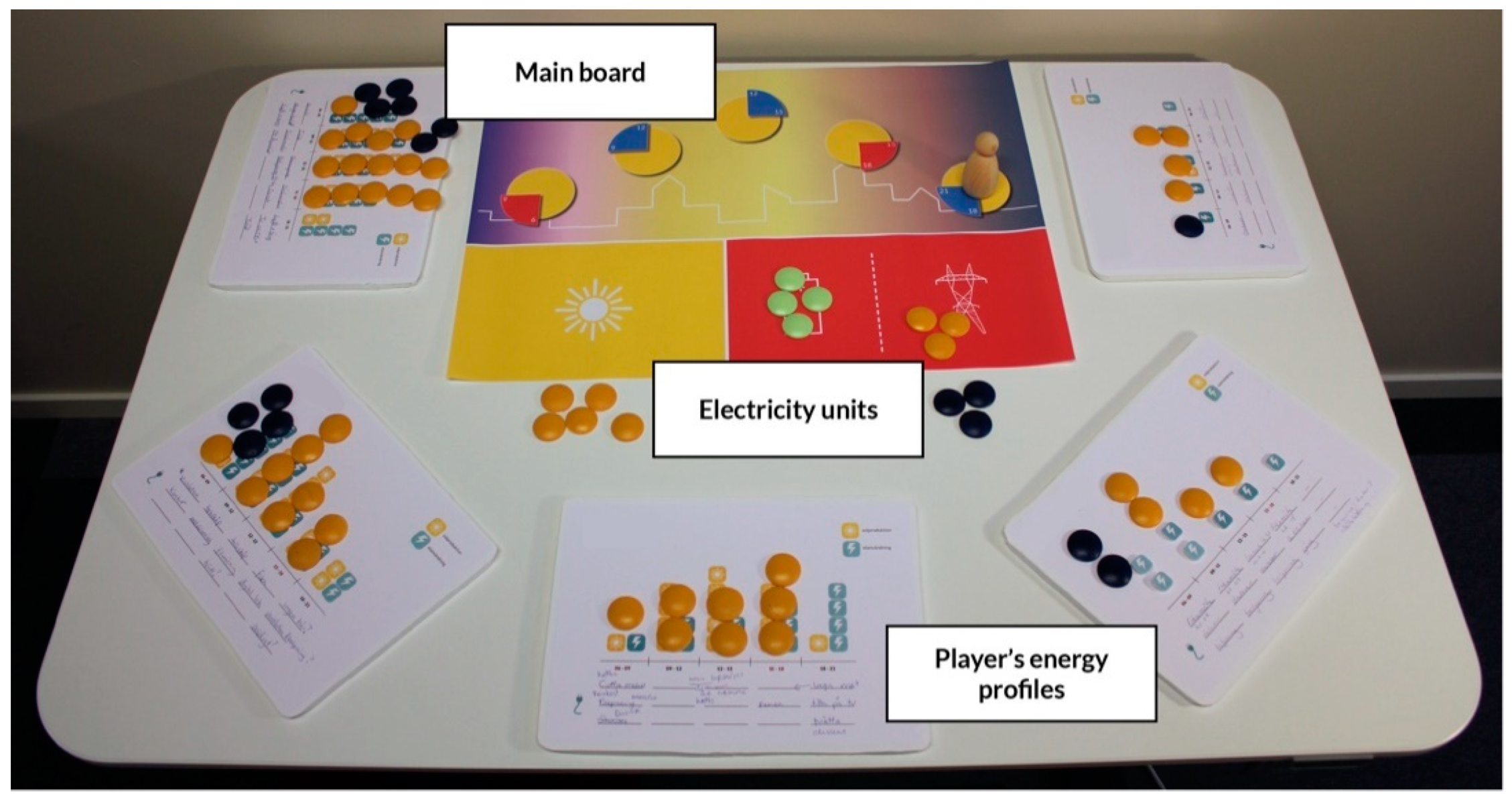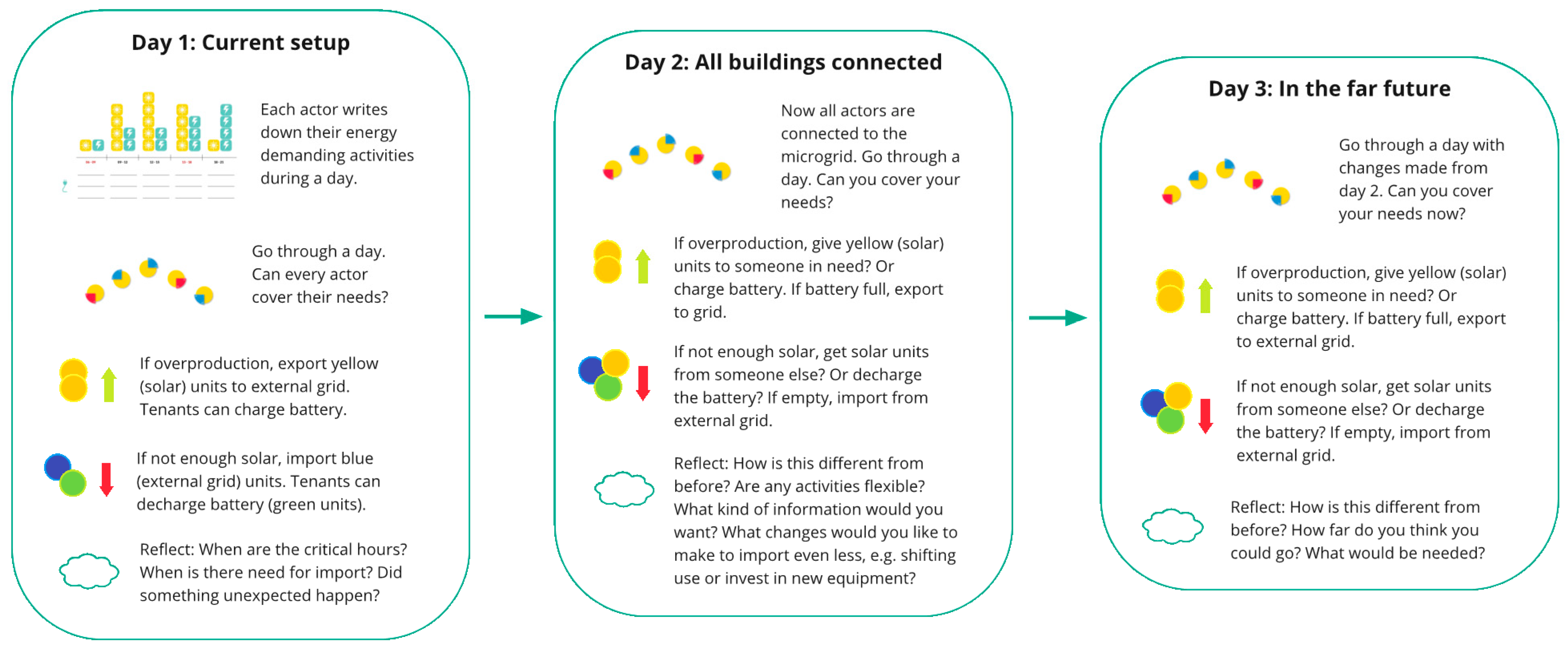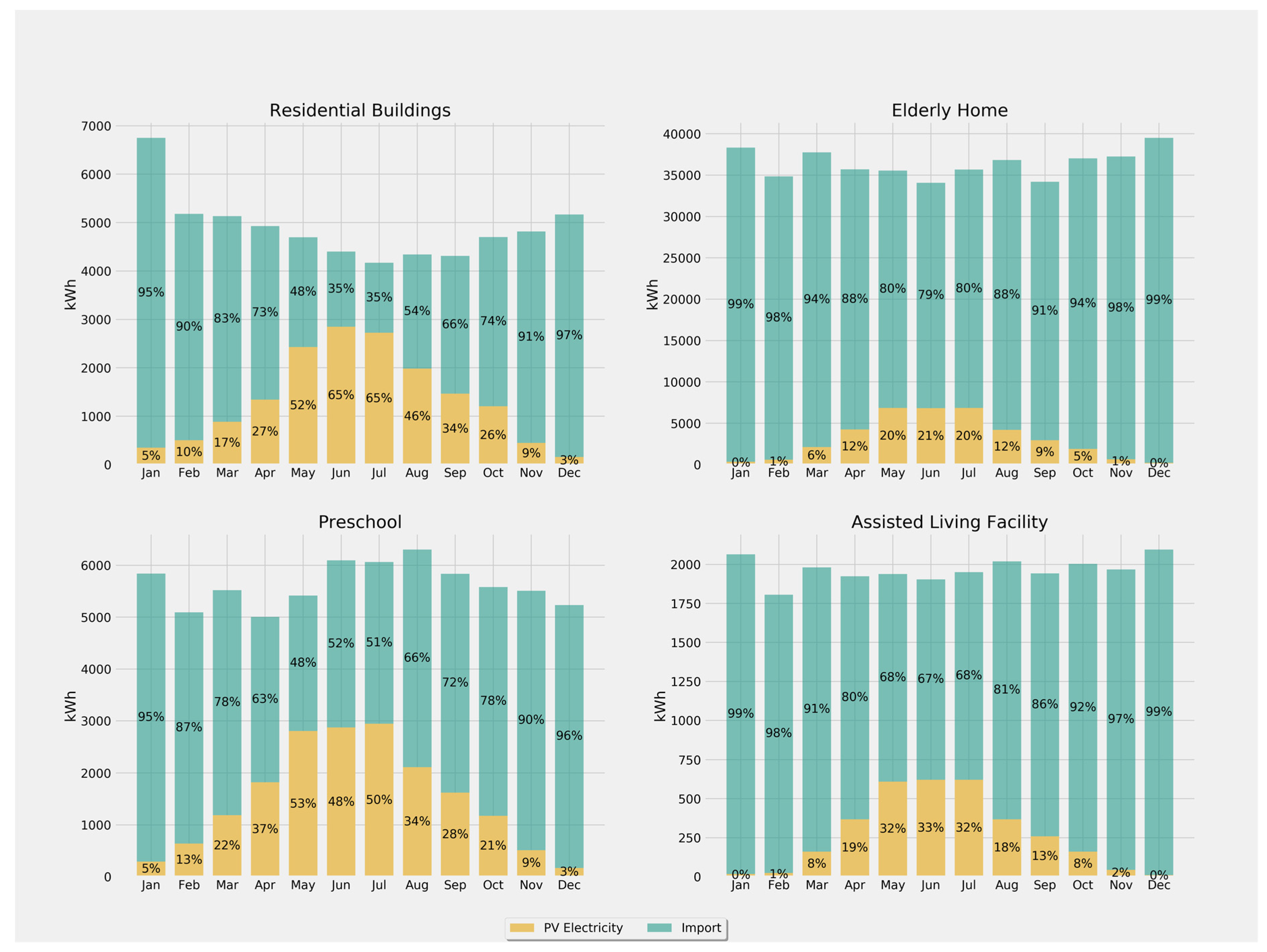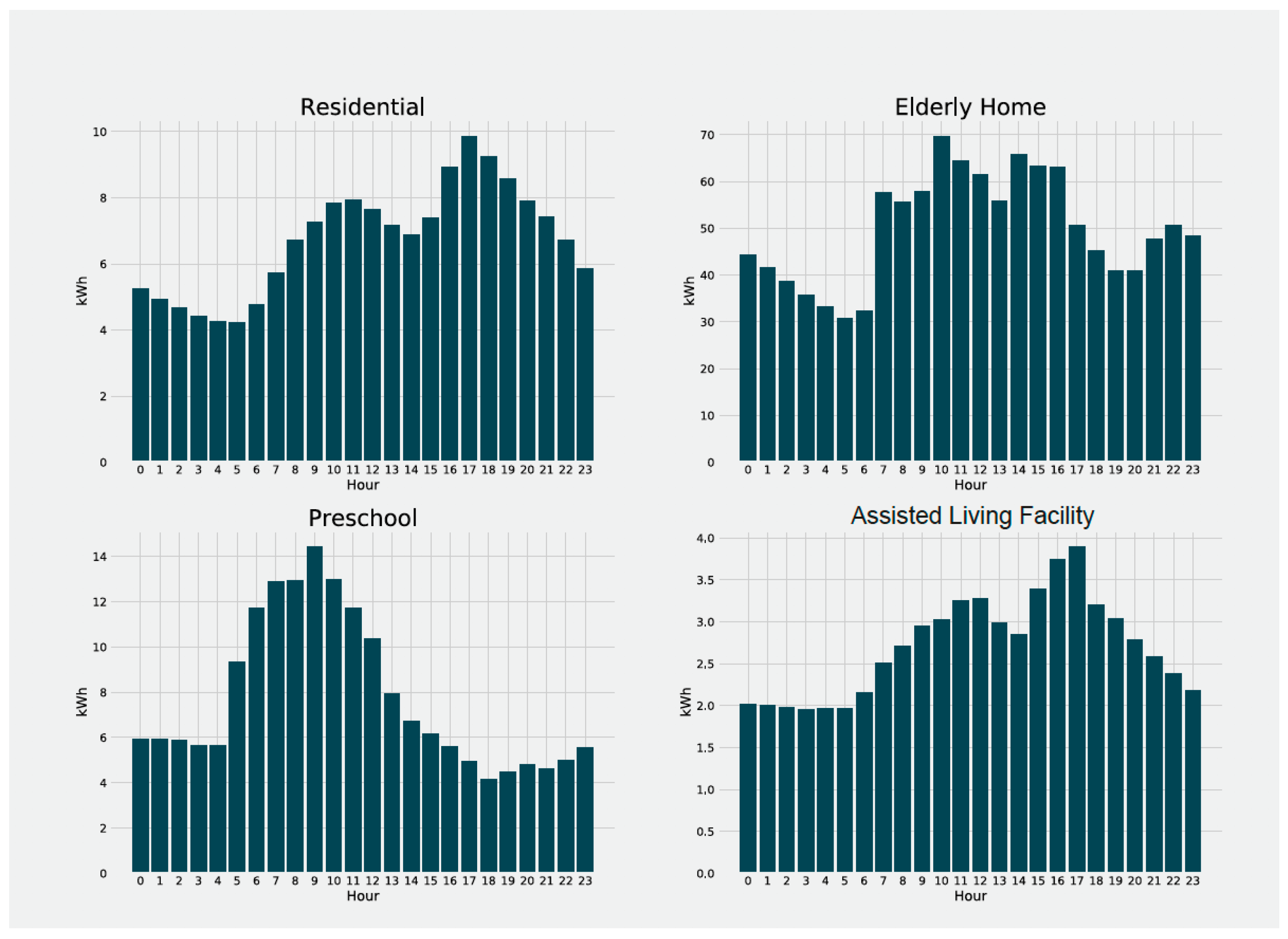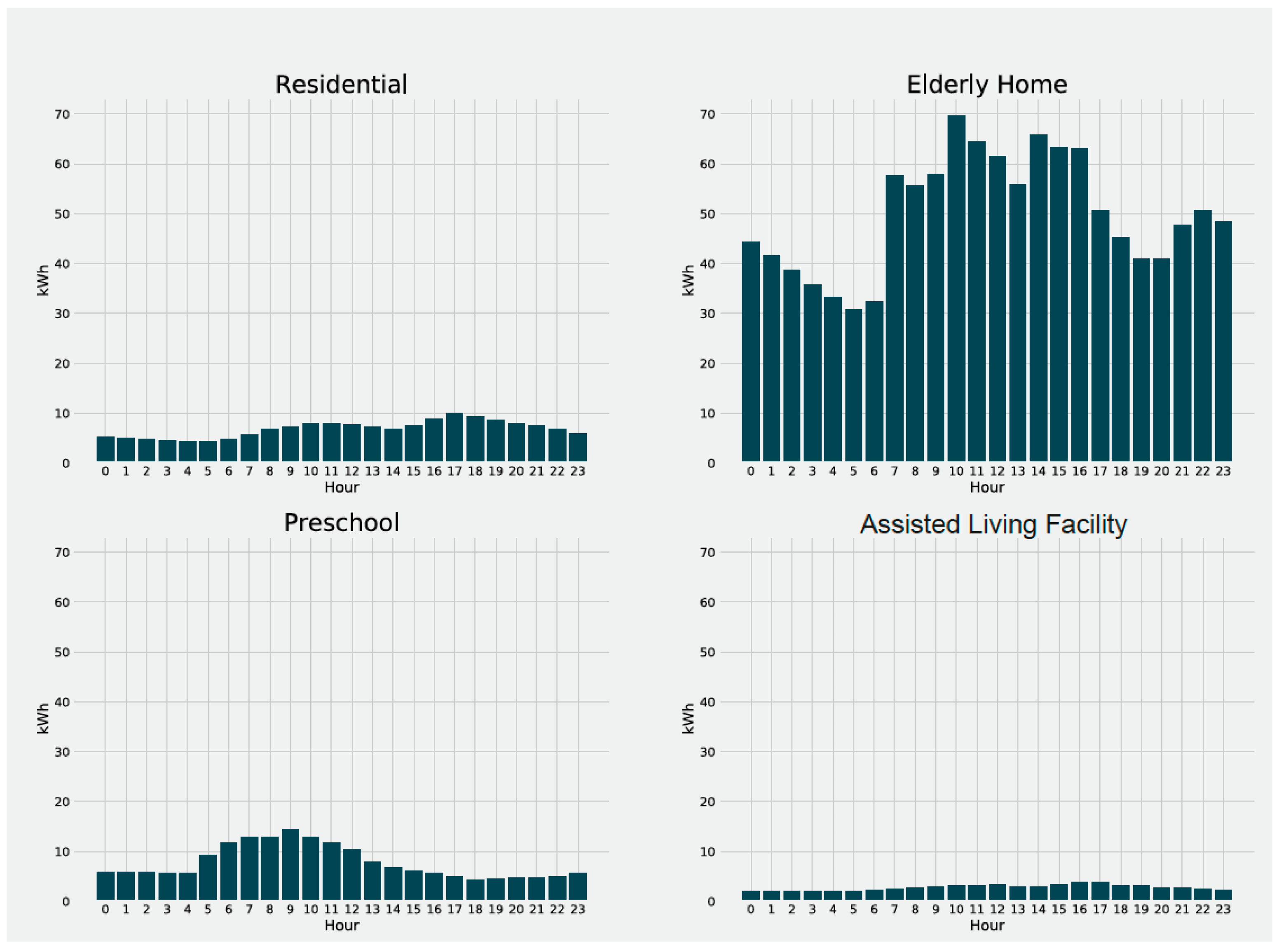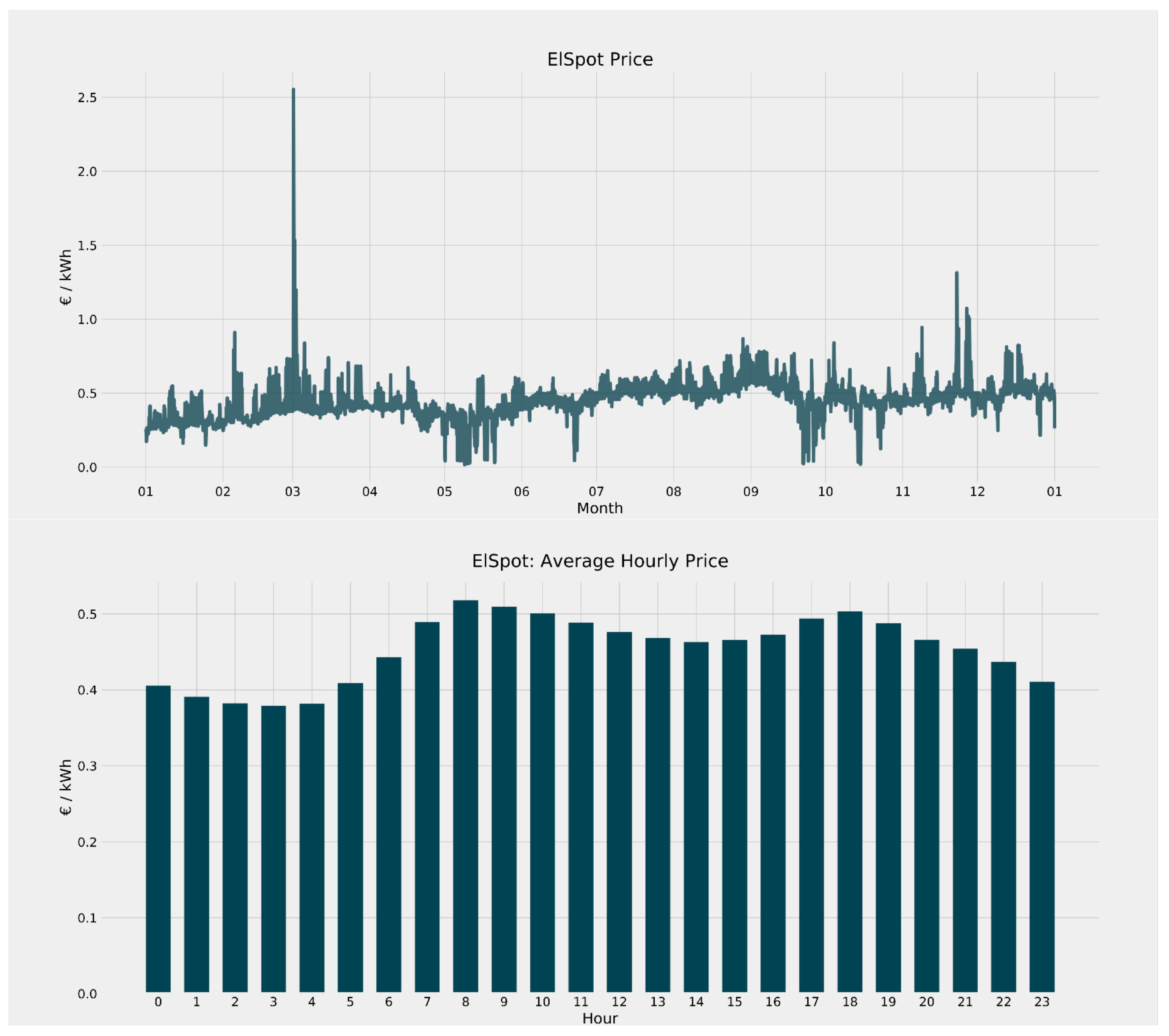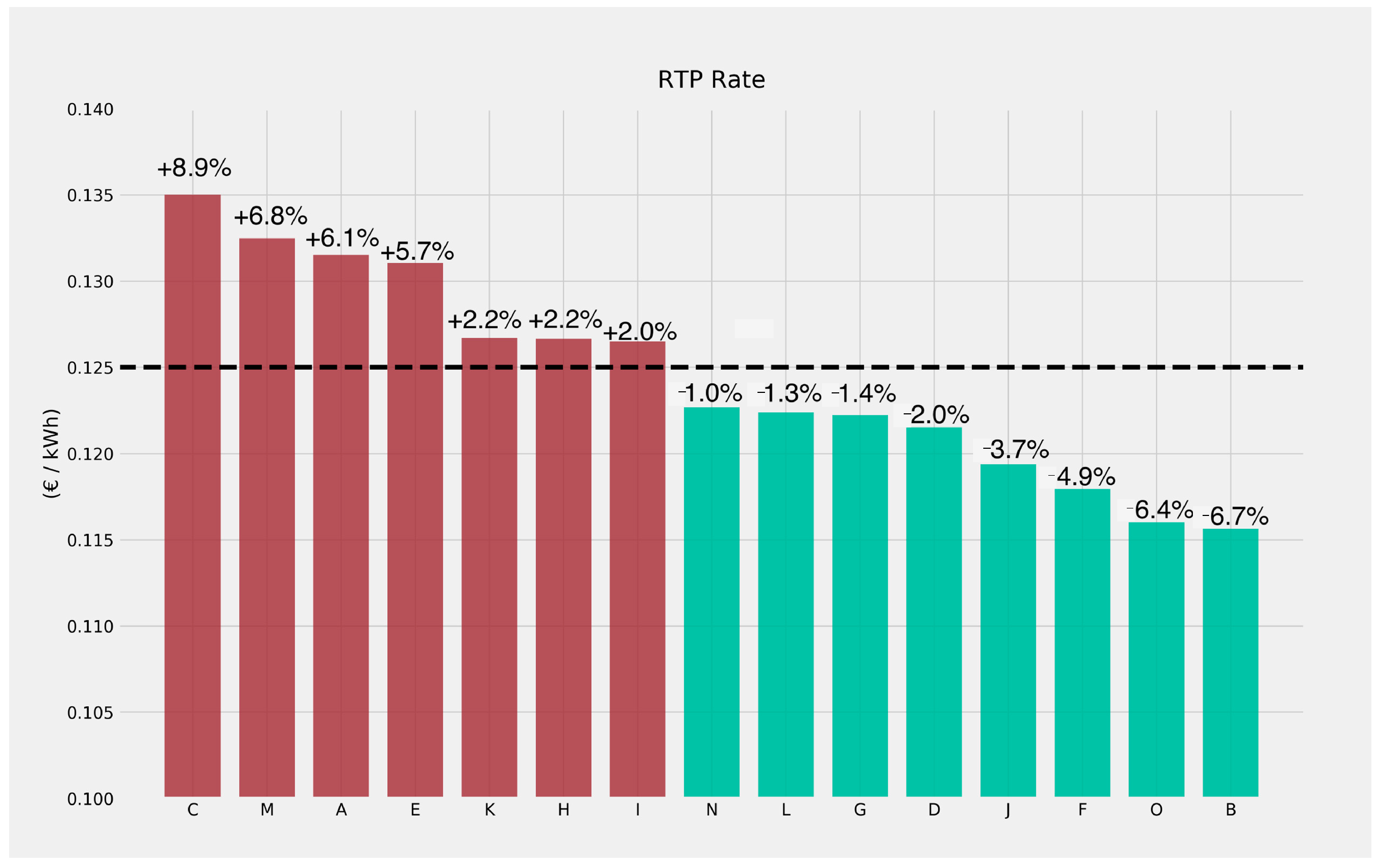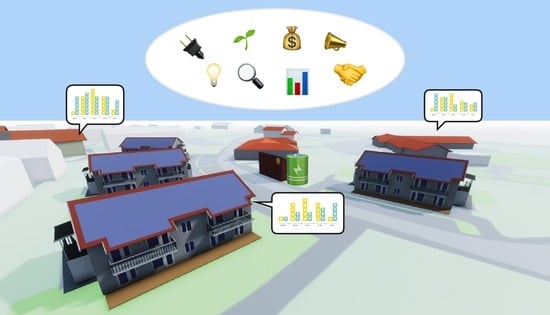1. Introduction
Efforts in climate change mitigation are being hindered by a formidable set of challenges. Within the electricity sector, reducing carbon dioxide emissions hinges on the ability of electricity grids to handle increasing amounts of intermittent energy. This needs to be achieved while maintaining a high standard of reliability, improving the grid’s overall resilience and curbing social costs. These factors, alongside calls to democratize and decentralize the electricity system, have rendered microgrids highly relevant to the energy transition. In recent years, microgrids have increasingly been implemented in urban locations, in contrast to their historical use in remote settings serving small populations [
1]. Lauded as a way to reduce emissions, empower communities and decentralize the power grid, microgrids are one form of an energy community [
2] that offers a range of theoretical advantages [
3,
4]. Yet, as this paper aims to demonstrate, it is in their practical implementation that unanticipated challenges become more apparent.
A defining feature of any microgrid is the ability to produce its own energy. With photovoltaic (PV) panels or other forms of distributed electricity generation, a microgrid is intended to function autonomously (to some degree), with little to no reliance on the external grid [
5]. One critical parameter by which microgrids can therefore be assessed is their self-consumption rate, which is the share of produced energy that is consumed inside a given microgrid:
where SC is the self-consumption rate of a given energy community, C is the amount of energy from the PV panels that is consumed (kWh) during a given time period, and P is the amount of energy produced by the PV panels (kWh) during a given time period.
This parameter is made more important by the problem of intermittency associated with the renewable energy sources often used in microgrid settings. Variable renewable energy sources such as wind and solar fluctuate in their supply, and if a microgrid can neither match that supply with its demand nor store the excess electricity, it will be forced to export that electricity to the external grid. Conversely, if there is no available power from its own energy sources and the microgrid’s demand exceeds its supply, it will then be forced to import electricity. The implication of this dynamic is that a microgrid could display a superficially high productive capacity while exporting most of its own electricity and re-importing it later, making its users no less reliant on the synchronous grid than they were prior to connection. Accordingly, the self-consumption rate serves as a performance measure that allows one to assess a microgrid’s ability to retain its own energy and maximizing this self-consumption rate is a goal that is therefore implicit in most microgrid settings.
The problem of self-consumption is fundamentally about a mismatch between the timing of supply and demand. The supply side lever is one that is decidedly rigid, due to the intermittent availability of power from renewable sources. One countermeasure is to store generated electricity that is not used. While storage technologies are currently undergoing a period of rapid development, they remain too expensive for wide-scale adoption. The second lever, and the focus of this paper, is the demand side measure of using behavior to shift electricity usage away from periods of excess demand towards periods of excess production and vice versa. Microgrids are not passive networks of electrical currents but are dynamic systems that are as responsive to the elements that power them as they are to the actors who use them. From an economic perspective, electricity is a commodity that is traded, bought and sold, but an everyday user may perceive it is an unintuitive, intangible good that must be used immediately and cannot be stored [
6]. Consequently, users are not intrinsically reflective of the implications of their consumption patterns and will not reflexively alter these patterns. Changing consumption patterns and employing behavioral change as a means to shift the timing of electricity usage therefore requires the engagement of users. This paper attempts to illustrate that this is a feat of considerable difficulty, and that its resolution is central to the future of microgrids and the energy transition at large.
Engaging electricity users and motivating them to reflect and act on the timing of their consumption requires substantial change in how electricity is conveyed and communicated. In the context of electricity use, the predominant medium through which information is conveyed to and from users is the electricity market—through prices [
7,
8,
9,
10]. Reshaping the architecture of the market is therefore one way to manipulate the signals being sent to users [
11]. Using price-based energy sharing models that alter the distribution of prices and incentives within a microgrid could generate benefits to the community as a whole [
12,
13]. In some cases, a centralized planner can be eliminated and prosumers could “trade” energy within the microgrid under a blockchain-based market [
14]. While most studies on microgrids have been based on models and simulations, studies looking at empirical cases of more general demand response programs have indicated that the price of electricity can play a role in helping manage demand [
15,
16,
17], but the extent of this role remains highly contested [
18,
19]. The short-sighted view of users as purely financially-driven and economically rational consumers can therefore result in an overreliance on the price of electricity as a policy instrument and limit the effect of demand response programs [
20]. One meta-analysis demonstrated that financial incentives may even lead to an increase in energy usage, a result that has previously been described as the “licensing effect”, where users find out that their expenditures and potential savings are so modest that they then felt “entitled to benefits from energy use because they are paying for it” [
21]. Such findings, alongside an absence of any consensus regarding whether and to what extent financial incentives are effective, suggest that any policy that targets user engagement should avoid an exclusive dependence on price signals.
Demand response programs and the flexibility of household electricity consumption have been studied from a range of perspectives. Previous demand response studies have for example investigated the relation between flexibility and gender [
22,
23], households with children [
24,
25], flexibility capital [
26], social practices [
27], temporality of everyday life [
28], user typology [
29] and non-self-selected prosumers [
30]. A systematic review of consumer engagement among households for demand responsibility can be found in [
31]. One way of communicating the need for flexibility is the use of electricity feedback, which has been shown to play an equal or more important role than pricing strategies [
32,
33,
34]. Feedback in the form of energy visualizations, through digital platforms for example, has been suggested as a tool that could enable households to take greater responsibility in the energy infrastructure by engaging in self-consumption or trading with energy [
35]. As is the case with pricing, however, feedback also has its limitations. A growing body of literature questions the idea that making energy usage visible to households will trigger behavior change and affect consumption [
36]. Studies have shown that the simple installation of smart meters and the provision of detailed feedback might not be sufficient to trigger consumer engagement [
37] as the technology fails to account for the more complex cultural and social contexts that influence energy use [
38]. As new technologies are introduced, new domestic practices will also emerge, making it difficult to impose fixed forms of communication on dynamic social contexts [
39].
Moving away from the view of users as recipients of prices and feedback, and instead viewing them as participants of the energy system might allow for new material forms of energy citizenship to emerge within households [
40], and consequently, new forms of engagement. The term energy citizenship has developed from the historical perspective of people as passive energy users or customers, to a more active perspective where people are encouraged by policies to be more active, for example through price signals [
40]. Exploring potential new forms of energy citizenship alongside the possibility to empower prosumers and households can shed light on the role they can play as active participants, democratically engaged in the sustainable energy transition [
40]. Inviting users to reflect upon and shape these roles co-creatively is one possible path to enabling a shared understanding of needs, challenges and everyday life activities; one possibility is the use of design probes as a method [
41].
Another concept that frames people as participants is that of energy communities. An energy community could be interconnected on a broad scale or be more geographically concentrated, initiated by either community inhabitants or a local authority and motivated by the pursuit of self-sufficiency, CO
2 neutrality or reduced costs [
42,
43,
44]. The constellation of actors in an energy community and their motivations for participating (or not) in these arrangements vary. Variables such as home-ownership and energy bills have been identified as key factors that influence citizens’ willingness to participate in community energy systems [
45,
46]. It should, however, not be assumed that all users want to be a part of an active energy community, and even fewer can be expected to be interested in controlling such a system [
47]. It is therefore prudent to account for the variations of users and consider the provision of a variety of energy citizenship roles that cater to the diversity of skills, preferences and interests among participants. We apply the term “user” to broadly describe any actor or stakeholder (residential, commercial or otherwise) that is (or would be) part of an energy community. We adopt the phrase “user heterogeneity” to encompass variations within and between these different types of users.
We explore the topics examined above in an empirical setting which consists of a small DC microgrid equipped with photovoltaic (PV) panels. Composed of four newly built residential buildings with 16 rental apartments ranging from 66 m2 to 95 m2, the microgrid is also set to expand and include a set of municipal actors: an elderly home with 58 apartments, an assisted living facility (ALF) with six apartments, a 950 m2 preschool and a caretakers’ office. The caretakers’ office and two of the residential buildings are the only buildings without PV panels on the roof. The housing agency behind the decision to establish the microgrid owns the buildings set to be connected. According to the housing agency, most of the buildings are built according to the passive housing criteria with features such as thick walls for more energy efficiency. A total of six buildings are already equipped with PV panels, and almost all have been exporting electricity to the synchronous grid in varying amounts. It is a combination of these circumstances that allow us to describe the microgrid’s users as “passive prosumers”. They are prosumers because they are part of an entity that produces and consumes energy, but passive because they were not part of the decision to become a prosumer. Through connecting these buildings, the housing agency’s vision was to first maximize self-consumption and then potentially install more PV panels in an effort to become entirely self-sufficient. While the microgrid was equipped with battery storage, it was limited to a capacity of 21.7 kWh, far short of what was necessary to eliminate electricity exports.
Given the context and specific circumstances, we set out to study practical and economic aspects such as the self-consumption rate and current cost distribution along with price signals, as well as user-centered aspects on how the microgrid was communicated, experienced and understood. We believe that previous research has targeted various strands of the topics discussed above, but that there is a lack of research on empirical settings that consolidate the above topics and shed light on the interplay of the various difficulties and challenges in their realization. We aim to offset this deficit with an empirical multidisciplinary study of an operational microgrid that can serve as an illustrative case and a reference point for future studies. Accordingly, our purpose with this paper is to identify practical challenges in engaging microgrid users to increase self-consumption, and so our contribution to the current literature is a summary of the various considerations that must be weighed and the possible complications that may emerge, in the institution and management of a microgrid.
The paper is structured as follows.
Section 2 describes the methods used for analyzing the electricity consumption, production and its associated costs, as well as using design interventions to explore users’ understanding and perceptions of the microgrid.
Section 3 describes the results found with these methods.
Section 4 discusses the results and summarizes our learnings as input for future research.
4. Discussion
In this section we consider the implications of the previous results and attempt to draw attention to a set of issues which we deem highly relevant to the topic of energy communities. We set out to explore user engagement as a means to increasing self-consumption and sequentially present the main challenges that were identified. We begin with elaborating on the problem of price signal impedance and the flaws of flat rate pricing. We then consider obstacles to the extension of an internal price model to various actors in a microgrid. We examine the limits of price signals and financial incentives that emerge when dealing with user heterogeneity and highlight the importance of a user engagement strategy that employs an integrated approach to user engagement. Finally, we outline how this integrated approach requires one to consider how to instill a basic level of awareness in an energy community, how to frame the electricity flows of a system and the impact of a user’s behavior on this system, and how to align incentives for behavioral change through fostering a sense of community.
4.1. Price Signal Impedance
A fundamental component of any approach to engagement is the transmission of information. If users are to be engaged concerning their electricity consumption, they could benefit from information on their current habits and “signals” that convey the effect of a behavioral change. These signals could take a variety of forms, but we begin with considering prices, and how they could be used as signals in microgrids or other similar settings. There is no consensus on whether price signals would be acted on as “pure” financial incentives. Regardless, they could still play an informative role in communicating conditions of supply, demand and self-consumption. Pricing schemes that take dynamic prices and convert them to fixed or volumetric rates, such as the case in our empirical setting, obstruct any signal from reaching the end user. These include intraday signals between “peak hours” and hours that have high low spot prices or high PV production, but they also include sizable seasonal signals, with winter months being substantially more expensive than summer months. Additionally, they result in a regressive cross-subsidy from some users to others. Those who use electricity from the synchronous grid at cheaper times and/or use more PV electricity are effectively subsidizing the consumption of those who use electricity from the synchronous grid at more expensive times and/or less PV electricity. A more cost-reflective price model, such as the one suggested in the sections above, would allow the transmission of these price signals. As mentioned, even if the price model does not incite a strong demand response through a financial incentive, it could still bolster an engagement strategy that emphasizes the importance of the timing of one’s electricity consumption. At the very least, a more cost-reflective price model would create a more equitable distribution of costs between the apartments, where users pay according to both the amount of electricity they use and the timing at which they choose to use it.
4.2. Extending the Price Model to Other Actors
In the empirical context that was the subject of this paper, the price signal was strictly applicable to the residential buildings. The municipal buildings could not be included primarily because the costs of their electricity consumption were handled outside the jurisdiction of the housing agency, and so whether they could formally or legally be subject to an internally managed price model was ambiguous. This is an issue that may surface in a more general form within energy communities and raises important questions regarding their internal management. Even if all parties were to agree to the adoption of a price model, there is currently no formalized legal framework for internally repricing electricity inside a microgrid composed of different actors. Despite the housing agency owning these buildings, the costs incurred and paid by the municipal actors were handled between the municipality, the DSO and retailer, outside the administrative authority of the housing agency. While it is conceivable that a commercial actor could informally agree to an internal price model with other actors, public actors are subject to a more rigid set of rules and regulations which may limit the extent of their participation in an energy community [
2]. The need for legal frameworks that enable energy communities and support renewable expansions has been identified and discussed, but the extent of their autonomy and their ability to carry out policies such as the internal redistribution of costs requires further development and evaluation.
4.3. The Limits of Price Signals
Suppose a legal framework that incorporates the different actors exists, and that all have agreed to an internal price model that sends signals and provides economic incentives. An arguably more important impedance to these signals is the gap that exists between those responsible for the cost of electricity and those who use it. The price model proposed applied to a set of apartments that were occupied by users who paid for their electricity consumption, a situation where a financial incentive is clear, and a price signal is transmitted. If one were to instead consider an alternative rental situation, where tenants pay rent to owners, then including the cost of electricity in the rent would block any price signal and remove any incentive for a tenant to shift the timing of their consumption. This issue is even more pronounced in the case of the municipal buildings. In settings such as preschools and elderly homes, the employees who are the end users of electricity are not financially responsible for the costs of this usage and have limited flexibility on deciding when to use it due to fixed schedules and rigid routines. Even if the buildings were subjected to an alternative price model, the employees using the electricity would only be made aware of any change through a direct and targeted intervention from the higher levels of management responsible for these administrative functions. This is not an issue exclusive to microgrids and energy communities but is a mismatch of incentives that may exist in stand-alone buildings today. In the case where public actors such as the municipal buildings do adopt alternative price models and attempt to shift the electricity consumption of their employees, they cannot exclusively depend on a price signal, for the simple reason that their employees would still not be financially accountable for their consumption. Engaging a heterogenous set of users, that includes both tenants who pay for their electricity and employees who are solely users, alongside a more general set of public and perhaps commercial actors, requires the consideration of other forms of signals and incentives, and a broader, more flexible engagement strategy.
4.4. Extending the Engagement Strategy
When designing an engagement strategy that includes alternative, non-financial components, an “environmental signal” is one reasonable candidate given the grander context of the role renewable electricity plays in the energy transition. Indeed, some of the actors spoken with expressed an interest in receiving information regarding the environmental impact of the microgrid. An “environmental signal”, usually quantified as the amount of CO
2 offset or conserved by carrying out a specific action, could appeal to certain types of users and create an incentive for those who would not be motivated by cost reductions. Like the price signal, it is not clear whether an environmental signal could induce a demand response on its own accord, but it could complement the price signal and play an important motivational role in the engagement strategy. This possibility was complicated by the outcomes of a life-cycle assessment (LCA) study performed on the microgrid [
51]. The study concluded that electricity from the synchronous grid emits less CO
2 than that from the microgrid. Despite the microgrid using PV electricity from solar panels, its carbon footprint was higher than that of the mainly nuclear electricity (which has lower CO
2 emissions) that came from the synchronous grid. This is an important limitation, and points to the difficulty of offering an environmental incentive when an environmental signal cannot be condensed into the simple message of off-setting a certain amount of CO
2. This applies in any setting where a given country has a large share of renewable or nuclear electricity in the synchronous grid. Other approaches could involve the use of alternate forms of information and feedback, though the type of information, the sentiments to appeal to and the format through which to convey this feedback are difficult specifications to select given the heterogeneity of the microgrid’s users. The limitations of price-based and environmental feedback have been discussed, but other channels include normative or feedback on historical use, which has sometimes been employed in residential settings but could possibly be adapted to non-residential users as well. It is worth reiterating that the microgrid’s users range from private tenants and elderly home occupants, to caretakers, cooks and teachers. It is difficult to envisage how an indiscriminate engagement strategy based on a unidimensional signal of any sort could be applied to the microgrid while resonating with all its various constituents. Appealing to a collective sense of community however, perhaps a common denominator for all users, could be a central feature of a multifaceted engagement strategy, and resolve some of the mentioned difficulties.
4.5. User Engagement
Instilling a sense of community and shaping a collective identity introduces a further set of challenges in how users are introduced to and perceive their role within an energy community. Addressing these challenges is critical in order for people to adopt the role of energy citizens and become more democratically involved. We will here describe these challenges and exemplify them using experiences from the design interventions.
First, we report that in our empirical case, the existence, function and advantages of a microgrid have not been communicated to its users. Even in the most basic strategies for engaging users, information should be distributed about what a microgrid is, why it was built and why people should care about it. The lack of any communication explains why no one in the microgrid knew of its inception or existence, and we argue that this basic awareness is a fundamental preliminary step to engaging the microgrid’s users.
Secondly, it was observed that since people did not know about the microgrid’s existence, they were unaware of the basic electricity flows in the system and unable to form their own understanding of it. Technical representations of electricity systems such as wiring diagrams are not easy to understand for its everyday users (as illustrated by the system’s wiring diagram in
Figure 11). The microgrid toolbox and the microgrid board game fulfilled their function as discussion and learning tools for the project to shape an understanding of system technicalities and electricity flows in a more user-friendly way. For designers, whose knowledge on electrical inverters and DC grids is very limited, the microgrid toolbox also functioned as a translator between our mental model of the system and its proper functions. Similarly, the board game allowed the researchers and participants to discuss what room there is for flexibility and when and how sharing electricity with others could work. It might be valuable to further address these human values and explore how sharing electricity with other users and facilities is perceived and whether users can ascribe any personal meaning to living in a microgrid. These human value and mental model aspects are important to explore, as they can explain a lot about why users act the way they do in relation to technologies and energy practices [
52]. We encourage future research to further explore what tools for enabling co-creative dialogue in small-scale energy communities could look like, and also encourage cross-disciplinary research teams to use these tools for bridging perspectives.
Our third challenge concerns a user’s awareness of their electricity consumption practices and how this relates to other participants’ practices. As seen from the qualitative findings, users’ knowledge of energy intensive appliances were varied. One way of translating this could be through their consumption profile, i.e., how much they produce and consume, as we tried to illustrate through their average daily consumption and production in the board game. Although this needs to be tailored to the users’ knowledge and interest in the system, it can provide a brief understanding of what their consumption pattern looks like during an average day. Different user roles can also be expected to have different levels of energy awareness, literacy and motivations [
29] which still is only one part of everyday life that has an impact on energy practices. Feedback can also be given on a more frequent basis, through digital applications or in-home displays. However, careful consideration is needed, since simply providing energy feedback or other smart metering technologies is argued to be insufficient to stimulate user engagement [
36,
37] and this might be particularly complicated with rental apartments [
46]. It may be valuable for users to also get a feeling for how others’ profiles look like in relation to their own in order to encourage reflections on what their energy practices look like from a more holistic perspective.
Fourth, if participants in an energy community are expected to alter their practices or shift their energy usage, users need to be able to co-create their incentives for doing so. If the incentive is further outlined to include some kind of goal for the entire community (e.g., percentage of self-consumption rate), this needs to both be democratically agreed upon by all users and to be realistically achievable. As exemplified by the focus group with the board game, it may be very valuable to have a dialogue and create an understanding of each other’s incentives and possibilities, fostering a sense of community. The collective factor of taking part in a joint effort deserves further attention as simply being part of a community may function as a motivating factor [
42].
Lastly, we highlight the importance of working closely with users around expectations and responsibilities and allowing more diverse forms of participation in this type of small-scale yet diverse energy communities. Future studies could study how participatory methods where users are involved and empowered in the development through new forms of energy citizenship can be related to a sense of community as wished for by some of the public actors and the housing agency. Furthermore, we recommend future research and similar interventions to adopt a mindset of engagement and dialogue, acknowledge people as energy citizens and allow for participation in the community on more democratic foundations.
5. Conclusions
5.1. Summary
Microgrids are complex structures that combine a variety of actors with equally various backgrounds. A central feature of any microgrid is the ability to produce and harness its own energy, developing a degree of energy independence. Producing electricity that is ejected into the synchronous grid only to be purchased back later undermines this independence. Self-consumption is therefore a sensible metric to consider when evaluating the performance of a microgrid. Aside from expensive and technical solutions such as energy storage, behavioral change is one clear lever for increasing self-consumption rates, and it relies on engaging users. Engaging users demands an understanding of the signals and incentives that could be used for communication, differences between them and their respective interests, as well as their subjective interpretations and understanding, as constituents of an energy community. This range of issues has usually been addressed separately in the previous literature. Through collectively studying these topics, we hoped to place them in a broader context and shed light on the challenges that arise not just from each, but from their intersection as a whole.
In this paper, we investigated an empirical case of a DC microgrid equipped with PV panels. We sought to identify challenges in engaging the microgrid’s users and motivating them to increase the self-consumption of PV electricity. To do so, we employed different quantitative and qualitative approaches that allowed us to explore the physical and social dimensions of the microgrid. We conclude that flat volumetric tariffs impede intraday and seasonal price signals from reaching end users and create a regressive redistribution of costs. We emphasize the need for dynamic, cost-reflective price models but recognize the lack of a formal framework for extending these models to various types of actors and stakeholders within a common energy community. We describe the limits on price signals and financial incentives in settings with a heterogenous set of actors, and highlight the need for a broader approach that incorporates a wider set of motivators while appealing to a collective, community-based identity. We finally address the challenge of conceiving an integrated approach to user engagement, and the significance of centering it around awareness, an understanding of electricity flows and the impact of behavior, the co-creation of incentives and the importance of using participatory methods to stimulate dialogue throughout the process.
5.2. Policy Recommendations
We firstly recommend the removal of any and all obstructions to price signals in both residential and non-residential settings. Even in the absence of renewable energy sources, and aside the goal of incentivizing an increase in self-consumption, the real-time price of electricity is a signal that reflects the market conditions of supply and demand. When these prices are not transmitted to their end users through scenarios such as “averaging out” total costs into a flat rate, or including electricity in rents, whether to private tenants or non-residential actors, these signals are blocked and unfair cross-subsidies between different users take place. Energy communities should then be encouraged to design and adopt internal price models (among other tools) that suit their collective goals (such as increasing self-consumption). We therefore recommend the formulation of supportive legislative frameworks that strengthen the autonomy of energy communities and their ability to locally govern. We then recommend that increased attention be given to the problem of user heterogeneity in energy communities, and to avoid an overreliance on prices and financial incentives as a demand side management panacea. Policy and research should target and investigate the potential of broader multifaceted approaches that incorporate various tools in engagement strategies that may appeal to a diversity of users with various motivators and barriers.
5.3. Methodological Considerations & Future Work
Each of the approaches used in the methods above could have been improved through more elaborate and detailed designs. Specifically, from the quantitative side, a pilot study on the implementation of the alternative price model, and a statistical evaluation of its effect would have undoubtedly benefited the study in its identification and description of practical challenges. The reason this was not carried out was the reluctance of the housing agency to carry out a full-fledged intervention. Given that the price model would be “internal”, the housing agency would be responsible for the practical implementation of this new model, including the calculation of costs, the re-design of invoices and the communication of the need and benefit to the tenants. This required a degree of commitment and organization that was not within the capacity of the housing agency at the given time. The reliance of the cost distribution analysis on a single year of data limited our ability to draw general conclusions regarding the distribution of costs. The analysis itself was, as mentioned, rather crude and amounted to a “what-if” scenario under a more cost-reflective price model. We deemed this sufficient to express our concerns with the impedance of price signals and the cross-subsidization of electricity costs, but a more sophisticated time-series model could allow one to forecast how different pricing schemes could influence load patterns and demand levels. Additionally, it would be very interesting to explore the effects of a different price model and assess how consumption patterns change, perhaps a task for future research.
There were several methodological constraints on our qualitative data gathering. For the engagement aspect, more interviews and dialogues could have been held with participants to, for example, discuss their thoughts on living in a microgrid, how they view their electricity consumption or what they experience from having PV panels. Unfortunately, no additional dialogues were held due to limited interest from tenants. The microgrid toolbox was designed with a more informed user in mind, resulting in a difficult situation when trying to invite tenants for participation with it. Similarly, the board game was only tested with one actor which means that we cannot really conclude whether it filled its purpose. However, the approach of using a board game to explain and stimulate discussions around a microgrid with its users is novel and we therefore deem it relevant to explain and illustrate here and invite future research to explore its potential.

